Coping with Extreme Weather Events in Puerto Rico: Amphibian Research and Hurricane Maria
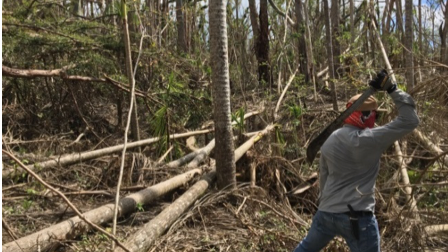
Ana C. Rivera-Burgos is a graduate student in the North Carolina Cooperative Fish and Wildlife Research Unit, North Carolina State University. Jaime A. Collazo is U.S. Geological Survey scientist and Assistant Unit Leader, North Carolina Cooperative Fish and Wildlife Research Unit, North Carolina State University. Adam J. Terando is U.S. Geological Survey research ecologist, Department of Interior Southeast Climate Adaptation Science Center. The following work is associated with SE CASC project, Climate Change Implications for the Conservation of Amphibians in Tropical Environments.
The Setting
Puerto Rico is the smallest and eastern most of the Greater Antilles (about 1,000 miles east of Miami, Florida). The other Greater Antilles are Cuba, Hispaniola and Jamaica. Because it is so isolated, Puerto Rico has very few species of mammals (except for bats) and fresh water fishes. However, other groups of animals – like amphibians – are diverse and many are found only in Puerto Rico. The island is home to 25 species of frogs, of which 17 species belong to the genus Eleutherodactylus (the inset shows E. wightmanae, melodious coqui) [1]. Although some Eleutherodactylus species are widely distributed and abundant (e.g., E. coqui or common coqui), many are specialized with ranges restricted to high mountain forests (e.g., E. portoricensis, E. wightmanae) or to lowlands and grassy habitats (e.g., E. brittoni, E. antillensis).

A unique feature of Eleutherodactylus species is that they exhibit direct-development [2]. In other words, they are not dependent on a tadpole stage during their growth to adults. This attribute helps them to pioneer and thrive in habitats away from permanent bodies of water. These frogs, along with lizards, play an important ecological role, notably in ecosystem energy flow. They effectively prey on invertebrates and their metabolic wastes (urine, feces) play an important role in nutrient cycling, returning nitrogen and phosphorous to soils, which also promote bacteria growth that help with leaf litter decomposition [2].
The Problem
Undoubtedly, the unique life history traits of Eleutherodactylus and the ecological services they provide (e.g., nutrient cycling, insect control) make them a conservation treasure. Unfortunately, most species (14) are at risk of becoming endangered. Two are already listed by the USFWS as endangered, and one is believed to be extinct. The primary cause of endangerment is habitat loss and degradation, primarily driven by urban sprawl and historic land use changes associated with agriculture in the 20th century [3, 4]. More recently, mounting evidence is suggesting that warming trends are taking its toll on populations through two mechanisms. First, because most species can only survive within a narrow temperature range, warmer and drier trends have triggered local extirpations of two species (E. eneidae and E. karlschmidti) at lower elevations at El Yunque National Forest [5]. Second, warmer temperatures have increased the incidence of a pathogenic chytrid fungus (Batrachochytrium dendrobatidis) in coqui frogs, causing decreased survival and reproduction [6].
The U.S. Fish and Wildlife Service and the Puerto Rico Department of Natural and Environmental Resources want to develop a portfolio of objectives and actions that could help enhance the status of endangered species, and importantly, prevent the endangerment of species considered at-risk. Responding to this need, the U.S. Geological Survey, North Carolina Fish and Wildlife Research Cooperative Unit, and Southeast Climate Adaptation Science Center were recruited to assist with the development of baseline knowledge and adaptation strategies to address the second objective – preventing endangerment of species at-risk. Our approach is multi-disciplinary, incrementally addressing different objectives to build a comprehensive but well-informed adaptive conservation strategy. Research topics include determining factors influencing occupancy, abundance, and reproduction, establishing physiological limits, discerning genetic structure, and making relevant urban and climate projections. This information is needed to inform decisions regarding the timing and implementation of adaptation strategies. Two examples are enhancing landscape connectivity and translocations [7, 8]. Our initial work in 2015-16 focused on determining species-habitat relationships along altitudinal gradients and among three dominant types of land uses in the mountainous region of the island. This work sheds light on factors influencing the presence and abundance of three focal species, namely, E. wightmanae, E. britonni, and E. antillensis, and set the foundation to address other project objectives [1, 9].
The Research
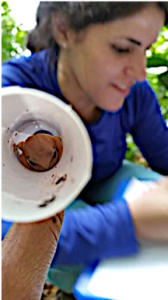 In 2017, Ana C. Rivera, a graduate student in the NC State Department of Applied Ecology, embarked on a research project designed to address two additional questions. First, along altitudinal gradients, what are the micro-habitat and -climatic conditions associated with reproduction, given that frogs are present and detectable in a location? Second, what are the temperature tolerance limits of the three focal species? The first question is of interest because it begins to expand our understanding of what influences reproductive activity, a fitness component. The second question starts addressing the upper portion (light green) of the flow diagram in the inset, that is, the relationship between a threat (e.g., rising temperatures) and a physiological response or direct effect of projected warming trends on the island [10].
In 2017, Ana C. Rivera, a graduate student in the NC State Department of Applied Ecology, embarked on a research project designed to address two additional questions. First, along altitudinal gradients, what are the micro-habitat and -climatic conditions associated with reproduction, given that frogs are present and detectable in a location? Second, what are the temperature tolerance limits of the three focal species? The first question is of interest because it begins to expand our understanding of what influences reproductive activity, a fitness component. The second question starts addressing the upper portion (light green) of the flow diagram in the inset, that is, the relationship between a threat (e.g., rising temperatures) and a physiological response or direct effect of projected warming trends on the island [10].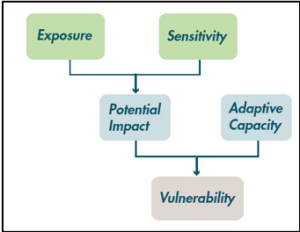
Field work started in earnest in spring of 2017, with a projected field schedule that included May-June (wet), August-September (dry), and October-November (wet) seasons, and laboratory experiments starting in August-September. These plans were brought to an abrupt halt by two hurricanes—Irma (category 5) and Maria (category 4). Hurricanes are an important and frequent driver of the evolution and manifest resilience of Caribbean ecosystems. For example, between 1944 and 1999, there was a 42% chance per year that San Juan, Puerto Rico would be affected by a tropical storm or hurricane, and a 3% chance of a direct hit by a hurricane of category ≥3 [11]. These events are of interest to conservationists because they can induce catastrophic consequences, not only to human endeavors, but also to vulnerable plants and animals (e.g., hurricane Maria wiped out the population of endangered Puerto Rico Parrot in El Yunque National Forest).
Ana’s project has become an example of succeeding in spite of adversity! Halfway through the second sampling season (August-September 2017), Puerto Rico experienced the effects of the two worst hurricanes in recent decades. On September 4, 2017, her team had to retrieve all the environmental gauges (e.g., acoustic, temperature and humidity recording units) from the study sites (48 stations along 2 altitudinal gradients), as hurricane Irma was projected to hit Puerto Rico on September 6, 2017. Fortunately, there was no direct hit and only a few sites were affected by the wind gusts of Irma. So, on the next day, Ana and her team went out to set everything up again, which took nearly a week. No sooner had they completed installing the equipment in the field than hurricane María appeared on the Caribbean seascape with a projected path that included Puerto Rico. On this occasion the forecast became reality. Maria made landfall on Puerto Rico just 2 miles/hr shy of a category 5 hurricane on September 20, 2017 (see inset).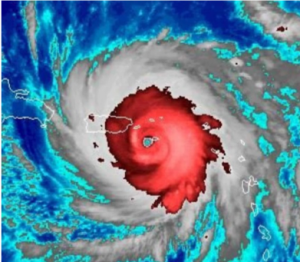
In Ana’s words…”Sheer devastation occurred across the whole of Puerto Rico. My team, Rafael Chaparro and Isamarie Acosta, myself, and our families call Puerto Rico home. The devastation of the storm turned our lives upside down.” “More than forty days passed before I was able to start field work again. And this meant just getting on a field vehicle to determine if our study sites had survived the impact of the hurricane. Landslides, damaged roads, houses without rooftops and debris were all we could see. A one-way drive that took us an hour each day, now took us four. What were secondary forests once were just leafless tree trunks in the aftermath of the hurricane. It seemed like everything had fallen.”
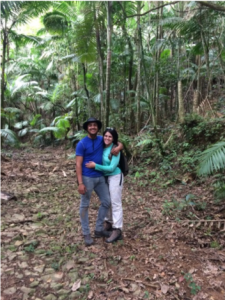

Sampling site before Hurricane Maria[/caption]The hurricane was a setback for Ana’s original research plan, but it also represented a unique opportunity to document demographic responses to such an extreme weather event. Of the 48 sites that Ana was working on originally, about 20 survived the impact of the hurricane—all others were devastated and not suited for research anymore. The insets show Ana and her fiancé, Rafael Chaparro, at one of the sampling sites before hurricane Maria, and then after the hurricane (Rafael is trying to clear a path on the same site).
Although Ana will be collecting data on the same demographic parameters (i.e., occurrence, abundance, reproduction) as before, collection at present is being done under a different setup. These are paired sites of those that survived the hurricane and reference sites that suffered little or no damage from the hurricane. This design will give her a chance to more clearly partition the effects of the hurricane from random effects or conditions. Moreover, it still allows her to look at pre-hurricane data for a more comprehensive “before and after” assessment. Also back on track is the experimental work, set to start with the assistance of Dr. Eloy Martinez (Eastern Illinois University) in October. He is an ecophysiologist, native of Puerto Rico. He will assist Ana with access to laboratory equipment and space, and training to help us secure an IACUC permit to conduct the work on thermal limits. Ana plans to defend her Master’s research in early spring 2019.
References
[1] Monroe KE, Collazo JA, Pacifici K, Reich BJ, Puente-Rolón AR, Terando AJ (2017b) Occupancy and abundance of Eleutherodactylus Frogs in Coffee Plantations in Puerto Rico. Herpetologica 73:297-306.
[2] Collazo JA, Terando AJ, Engman AC, Fackler PF, Kwak T (2018) Toward a resilient-based conservation strategy for the Rio Grande de Arecibo watershed: meeting challenges posed by land use and climate change. Wetlands (Invited). https://doi.org/10.1007/s13157-018-1080-z
[3] Radeloff VC, Williams JW, Bateman BL, et al (2015) The rise of novelty in ecosystems. Ecological Applications 25:2051–2068. doi: 10.1890/14-1781.1
[4] Joglar RL (1998) Los Coquíes de Puerto Rico: Su Historia Natural y Conservación. Editorial de la Universidad de Puerto Rico, San Juan, Puerto Rico. doi: 10.1643/0045-8511(2001)001[0576:BR]2.0.CO;2
[5] Campos-Cerqueira M, Aide TM (2017) Lowland extirpation of anuran populations on a tropical mountain. PeerJ 5:e4059; DOI 10.7717/peerj.4059
[6] Burrowes PA, Joglar RL, Green DE (2004) Potential causes for amphibian declines in Puerto Rico. Herpetologica 60:141-154.
[7] Heller NE, Zavaleta ES (2009) Biodiversity management in the face of climate change: A review of 22 years of recommendations. Biological Conservation 42:14-32.
[8] McDonald-Madden E, Runge MC, Possingham HP, Martin TG (2011) Optimal timing for managed relocation of species faced with climate change. Nature Climate Change (letters) 1:261-265.
[9] Monroe KE, Collazo JA, Pacifici K, Reich BJ, Puente-Rolón AR, Terando AJ (2017a) Occupancy and index of abundance of Elutherodactylus wightmanae and E. brittoni along elevational gradients in west-central Puerto Rico. Caribbean Naturalist 40:1-18.
[10] Hayhoe K (2013) Quantifying Key Drivers of Climate Variability and Change for Puerto Rico and the Caribbean. Final Report Oct 1 2011-30 Sep 2012. Agreement No. G10AC00582.
[11] NOAA Atlantic Oceanographic and Meteorological Laboratory, Hurricane Research Division, http://www.aoml.noaa.gov/hrd/tcfaq/G11.html
- Categories:
